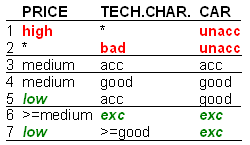Complex Rules
DEXi uses complex rules in order to represent its utility functions in a more compact and possibly more comprehensible way than with elementary rules (table rows). Complex rules are obtained by joining several elementary rules which have the same function value. In other words, a complex rule represents one or more elementary rules. In tables, complex rules are characterized by the use of intervals.
Example
This is the CAR utility function from the Car Evaluation Model, represented with elementary rules:

This is the same function represented with complex rules:

Notice the decreased number of rows from 12 to 7 and the use of symbols ‘*’ and ‘>=’. For example, the complex rule 1 says that if PRICE is ‘high’, and regardless on the value of TECH.CHAR., the value of CAR is ‘unacc’. This complex rule is a compact representation of the first four elementary rules.
See also
Complex rules of all the utility functions defined in the Car Evaluation Model.